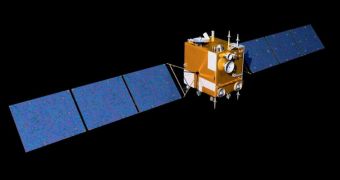Chang'e 2, a robotic spacecraft built and operated by the Chinese National Space Administration (CNSA), recently left lunar orbit, and moved on to a new leg of its mission. The probe is now headed to deep-space, collecting data and relaying them back to Earth.
The vehicle left lunar orbit on June 9, beginning an 85-day trek through space, that is expected to take it about 93,000 miles (nearly 150,000 kilometers) away from the Moon. This is the first time this type of maneuver was attempted and successfully completed with a lunar orbiter.
Chang'e 2 departed from Earth on October 1, 2010, and finally entered lunar orbit on October 6. Since then, it has been conducting investigations of the lunar surface, in a bid to find the perfect landing spot for an upcoming lander mission, which is scheduled for 2013.
The lunar stage of the flight was supposed to last for only six months, and it concluded in April, 2010. CNSA mission managers that undertook the necessary preparations to move the spacecraft away from Earth's natural satellite.
People's Daily, a Chinese newspaper, claims that the new part of the mission is designed to allow experts working with the Chinese State Administration of Science, Technology and Industry for National Defense (SASTIND) to gain more experience in manipulating spacecraft.
China is a relative newcomer to the group of nations capable of spaceflight, manned spaceflight and space exploration. Though its first manned flight took place in 2003, the country is now engaged in plans to finish its first space station by 2020.
At the same time, it is conducting lunar exploration, with the express purpose of putting both robots and humans on the lunar surface. Chang'e 1 was the first spacecraft of the series, designed more as a technology demonstrator.
Chang'2 actually conducted relevant scientific studies of the Moon, descending as close as 9 miles (15 kilometers) from the surface. It imaged both the north and south pole, but focused its attention on the northern Sinus Iridum, or the Bay of Rainbows.
This is a potential landing site for the 2013 mission, which will feature the Chang'e 3 orbiter and lander. CNSA released the first images of the area on November 8, 2010, Space reports.
“It's the first time in the world for a satellite to be set off from the Moon in remote outer space,” explains the deputy chief engineer of Chang'e 2's measure and control system, Zhou Jianliang, who is based at the Beijing Aerospace Control Center.
“We are developing outer space measure and control stations in outer space and they will be capable to carry out tasks by the end of the second half [of] next year,” an anonymous SASTIND scientist told the state Xinhua News Agency.

 14 DAY TRIAL //
14 DAY TRIAL //